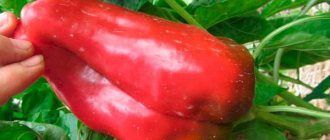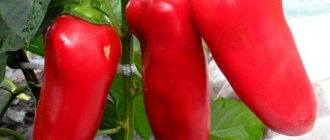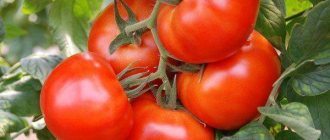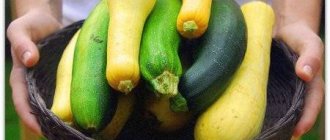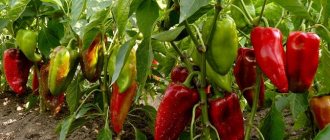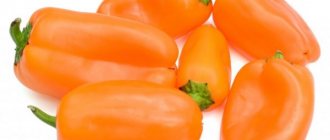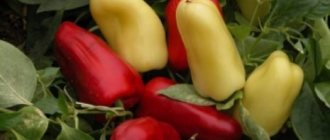Magno pepper is a sweet variety with early ripening. This variety is planted everywhere in Russia. The hybrid is of Dutch origin, but despite this, it withstands the vagaries of the Russian climate. Magno F1 is suitable for open ground, but more often it is planted in a greenhouse. The bushes are distinguished by a compact crown, as they belong to the determinant type. But the main advantage of pepper is, of course, its fruits.
Characteristics of the variety
| Parameter | Characteristic |
| Variety | Pepper MAGNO F1 (Capsicum annuum L. Magno EZ F1). |
| Description of fruits | Large, cube-shaped, with a glossy orange skin, thick walls and dense pulp. |
| Fruit weight | Max. – 250-300 g. |
| Color | At the stage of technical maturity - green, after full ripening - orange. |
| Form | In the form of a cube. |
| Fruit size | 10-12 cm in length. |
| Wall thickness | 7-10 mm. |
| Taste of the fruit | Pronounced, pleasant. |
| Productivity | Up to 5 kg in open ground and up to 14 kg in a greenhouse. |
| Maturation speed | 120-130 days. |
| Bush height | 1m. |
| Type of pollination (self-pollinating or not) | Self-pollinating. In a greenhouse, you can help with pollination by shaking the bush, since there is no wind. |
| Nestedness | Contains 3-4 nests. |
| Type of ovary formation | Formed singly. |
| Transportability and keeping quality | At a high level. |
| Resistance to adverse conditions | Good. |
| Resistance to diseases and pests | High. |
| Should I dive? | Yes, when planting in a common container. |
| Recommended growing regions | Central, Central Black Sea Region, Northern, Far Eastern, Ural, Lower Volga, Middle Volga, Volgo-Vyatka, Northwestern. |
| Year of inclusion in the State Register of the Russian Federation | 2015 |
| Originator | Enza zaden beheer bV (Holland). |
Description and characteristics
Breeders have developed quite a few varieties, as well as hybrid forms of this crop with orange fruits. And now you can not only buy in the supermarket, but also grow bright “sunny” peppers on your own plot.
Heat-loving peppers in most Russian regions are grown through seedlings. There are varieties with different ripening periods, bush heights, differing in shape, color and size of the fruit.
And among orange peppers there are also early, mid-early and mid-ripening, as well as those hybrids or varieties that ripen late. Many of them are adapted to certain regions, so when growing you should pay attention to these indicators.
Sweet pepper fruits usually acquire an orange color when fully ripe, but during the period of technical ripeness they can be green, cream, or yellowish. When the timing of fruit ripening is indicated, it is based on the number of days that pass from the emergence of seedlings to the stage of technical maturity. To harvest orange peppers, you need to wait another 2-3 weeks.
Quite capricious and requiring good care, pepper grows better under shelter - in tunnels, greenhouses, hotbeds. Tall varieties are usually planted in greenhouses; for medium-height and “short” peppers, shelters are installed directly on the ridges.
The size and weight of the fruit depend both on the variety and on the agricultural technology used. So, the fruits of the Sun pepper are round, light in weight (up to 100 grams), first have a bright yellow color, and then become orange. In the mid-ripening Orange bull, the “cubes” of fruits can grow up to 350-400 grams, while they are first bright green and only then acquire a bright “orange” color.
Properties
Why do peppers have different colors? The fruits of the plant contain natural phytonutrients, thanks to which the skin of vegetables acquires a specific color. In addition, these substances provide a certain effect on the human body, so by eating sweet peppers, we also improve our health.
The orange color of the fruit is given by beta-carotene, which is converted into vitamin A, which is very important for the normal functioning of the human body. Thanks to it, immunity is increased, protection against immune flora is provided, and metabolism is normalized.
ON A NOTE! In terms of vitamin A content, orange varieties of peppers are ahead of carrots, but slightly inferior to red peppers.
The strength and health of bones and teeth also largely depend on this vitamin. In addition to it, orange fruits also contain vitamin C and beta-cryptoxanine. They are the ones who are “responsible” for the youth of the body and prevent its aging and destruction. “Sunny” peppers contain a lot of potassium and phosphorus, which are necessary for the normal functioning of the heart and circulatory system.
When the pepper turns orange, it indicates that the fruit is already fully ripe. It is absolutely not necessary to wait for the bushes to ripen; you can pick green peppers, which then perfectly “reach” the condition at home.
Orange fruits are much sweeter and juicier than green ones; after all, they have already reached biological (that is, full) maturity. Thick-walled peppers are especially good, from which you can prepare wonderful stuffed dishes, lecho, all kinds of side dishes and snacks.
Description of the variety
The history of the creation of the hybrid began in Holland. Later the pepper was registered in Russia, this happened in 2015. First, the variety was tested in various climatic zones. After it was confirmed that all positive characteristics were preserved during cultivation, Magno was recommended for cultivation in 8 regions of the country.
The hybrid has limited growth rates. In open ground the bush grows no more than 1 m high; in a greenhouse it can be slightly higher. In the description of the variety, it is worth mentioning that the fruits have an excellent presentation and wonderful taste. Such a characteristic as yield is directly related to growing conditions.
In a greenhouse, the yield will be almost 3 times greater compared to open ground. On average, 8-10 fruits are collected from a bush. High productivity is achieved due to the large-fruited pepper. The leaf apparatus consists of large leaves with a wrinkled surface of a bright green color.
Landing
Seeds are sown 70-75 days before transferring to a permanent plant. Hybrid grains do not require treatment before planting.
The soil should be enriched with nutrients, but without excess nitrogen. It is prepared from peat, sand and garden soil in equal quantities, mineral fertilizers and wood ash are added, and then disinfected. To disinfect, the mixture is calcined in an oven or spilled with a solution of potassium permanganate.
Seeds are sown to a depth of no more than a centimeter and moistened. Keep under the film in a warm place (at a temperature of +25-26) until shoots appear. Then you can lower the temperature slightly, but not much. Provide seedlings with good lighting at least 12 hours a day.
After the first true leaves appear, they are planted in separate pots. You can feed once or twice with weak solutions of mineral complexes.
In the fall, the soil on the site is cleared of old tops, dug up and fertilized. Select areas after cabbage, radishes, radishes, carrots, onions, legumes, pumpkins, and zucchini.
Sweet peppers are placed away from hot ones.
Plant 3 bushes per 1 square. m.
Pros and cons of the variety
| Advantages | Flaws |
| Large fruit sizes | You cannot use your own seeds. |
| Attractive looking peppers | Dependence of yield on growing method. |
| Delicious sweet pulp | The need for gartering and shaping |
| Universal use | |
| High yield | |
| Disease resistance | |
| Good transportability |
Tips for growing the Magno variety
The taste and productivity of pepper directly depend on compliance with agricultural practices. First you need to grow the seedlings, and then provide the crop with proper care.
When to sow Magno pepper seedlings
When determining the timing of sowing seeds for seedlings, the growing season of pepper is taken into account. Magno has an average ripening period. Seeds are planted throughout March. In the south this is done at the beginning of the month, in the northern regions - at the end. The sowing time must be calculated so that the seedlings can be planted in the ground in 70-75 days.
How many days does it take for Magno pepper seeds to germinate?
Hybrid seeds normally hatch within 12-15 days from the moment of sowing, but sometimes this moment is delayed. For example, if the seeds have a hard shell or the room is quite cool, seedlings may appear only after 20 days. In any case, do not rush and re-sow. You need to wait 3 weeks or a little more for germination. The ideal temperature for seed germination is + 25-26° C.
When and at what distance to plant Magno peppers in the ground?
Pepper is a heat-loving crop. It can easily be destroyed by return frosts. For the Moscow region, the time for planting in a greenhouse is mid-May. In cold regions, the date is moved forward 2-3 weeks. In open ground, seedlings are planted 2 weeks later than in a greenhouse. Seedlings are placed according to a 40x60 or 50x50 cm pattern. Each plant should have enough free space to grow. For 1 sq. m should accommodate no more than 3-4 bushes.
Ripening period
The formation of the ovary begins simultaneously immediately after flowering. Each bush ripens 8-10 fruits, gradually gaining mass. The duration of the growing season depends on the growing region, current weather, and the availability of shelter. Taking into account all these factors, the growing season lasts 120-130 days from the moment of emergence. If you plan to transport the crop over a long distance, it is better to pick the fruits at the stage of technical maturity; they will ripen on the way.
Watering
Water the pepper only with warm water, previously poured into a barrel located in the sun. Watering is carried out in the morning or evening hours. Water is applied at the root, trying not to get on the stems and leaves of the plant. In hot weather, the bushes are watered every other day, in moderately warm weather - once every 3-4 days. After watering, the soil must be loosened to prevent the formation of a hard crust.
What and when to feed
Peppers are fertilized every 2 weeks, alternating mineral and organic fertilizers. In this capacity, you can use mullein, chicken droppings, wood ash, herbal infusion, humates and mineral mixtures (urea, potassium sulfate and superphosphate, nitroammophosphate). Bushes should be fed on moist soil, after watering.
Is it necessary to form a Magno bush?
The hybrid needs shaping. You need to form a bush in moderation. On the peppers, remove all the stepsons located below the first fork. The first bud is also removed. The bushes should be tied to a support. Since the plants are not too tall, they do not need a trellis. It is convenient to use individual pegs as support. Peeling is carried out in the morning so that the wounds have time to heal before evening. The formation of a crop has a positive effect on productivity.
Diseases and pests
Magno is resistant to tobacco mosaic and blossom end rot, but can suffer from some fungal diseases due to weakened immunity. Stagnation of water in the ground and poor ventilation contribute to the occurrence of infections. Fungal diseases more often affect peppers grown in a greenhouse.
For treatment it is better to use biofungicides:
- Fitosporin.
- Alirin-B.
- Glyocladin.
- Baktofit.
In open ground, bushes are often affected by aphids. It is better to fight insects at the initial stage of infection, using folk remedies - tobacco dust, ash solution.
Planting dates and care
Magno peppers have medium ripening periods. Depending on the region, climate and degree of soil protection, the growing season falls within the range of 120-130 days after germination. The time for carrying out basic agrotechnical procedures for central Russia assumes:
- planting seeds throughout March;
- planting seedlings under cover by mid-May;
- planting pepper in open ground towards the end of May or beginning of June;
- The fruit harvest is spread between the beginning of August and September.
Hybrid Magno F1 seeds, which were purchased from a reliable manufacturer, do not require pre-treatment or disinfection. The seed material has good germination and protection from diseases. Seeds collected independently will not be a good basis for planting, since the hybrid does not bear the characteristics of the mother variety.
Magno pepper seedlings proceed as standard; it is additionally recommended to apply complex fertilizers that stimulate growth. Fertilizers are first added to water during irrigation 10 days after seed germination. Repeated strengthening of the growing season is necessary a week before transplanting into the ground. The seedlings are ready for the planting procedure after 70-75 days.
3-4 bushes should be planted per square meter of prepared beds. The pepper does not need excessive depth. When grown, the crop requires pinching, by removing side shoots from below until the first branching. Bushes in hot climates need to be watered every other day, and fertilizers should be applied every 2 weeks.
Analogs
In terms of commercial quality of fruits, several other hybrids can be compared with Magno. Among them:
- Orange beauty.
- Orange lion.
- Orange delight.
- Orange Wonder.
If you compare the listed varieties with each other, you can find a lot in common between them. All of them are distinguished by their large sizes, the same color and shape of the peppers, and they tolerate transportation well, thanks to their thick walls. The yields of the listed hybrids also delight gardeners with their scale.
Magno pepper is a relatively new hybrid that Russian summer residents have already fallen in love with. Large orange fruits with thick walls are in demand among buyers, and the crop is often grown for sale. Pepper tolerates transportation well and does not get sick if agricultural practices are followed. The taste of the fruit is rich, sweetish. The harvest can be used fresh, frozen and processed.
Other orange varieties
This section of our review presents peppers that have a later ripening period. In the conditions of the North-West, regions of the middle zone, Siberia, and the Urals, they should be planted only under shelters and provided with good care.
Sun
The fruits of this pepper variety look like small pumpkins - bright, orange-yellow, with clearly visible segments. It will take up to 120-125 days to harvest the first fruits from the Sun.
The bushes reach a height of approximately 80 cm, fruiting is abundant and long-lasting. The plant ripens many brightly colored fruits, weighing on average 70-85 grams.
The variety belongs to the group of thick-walled peppers, characterized by very thin skin and delicate juicy pulp. Pericarp – up to 4-5 mm. The yield is superior to many tall varieties; from one square meter you can collect approximately 7-8 kg of sunflower fruits.
Firefly
The drooping yellow-orange fruits of this pepper glow like lanterns against the dark green foliage. The variety is productive, unpretentious, and mid-season in terms of ripening.
Peppers can be harvested green when they reach the maximum weight for a given variety - 140-150 grams. The fruits are cylindrical in shape, thin, with walls up to 2-2.5 mm. The taste of Firefly is similar to many standard sweet peppers, the aroma is weak.
It grows well in garden beds, but the best results are obtained when planting the Firefly variety in a greenhouse and under shelters.
Orange King
This variety produces up to approximately 4 kg of fruit per square meter. meters. The pepper is indeed Royal - with bright, orange fruits, the weight of each of which reaches about 160-170 grams.
The variety is sown early, around mid-March, and grown through seedlings.
The fruits are very tasty, with a characteristic peppery aroma. The pulp is sweet, rich in carotene. The variety is included in the State Register and is grown in a variety of regions.
Ryzhik
Ryzhik pepper is a thick-walled, sweet and juicy fruit weighing up to 160 grams.
The variety belongs to the category of early peppers and is well suited for growing in areas with harsh climates. In the short summer period, the fruits not only have time to reach a period of technical ripeness, but also fully ripen on the bush (when grown in a greenhouse).
You may be interested in: Favorable days for planting pepper for seedlings in 2022: terms and rules for sowing at home Favorable days for picking pepper in 2022 according to the lunar calendar Favorable days for sowing sweet and bitter pepper for seedlings in 2022
The fruits of Ryzhik are large, with a thick pericarp, up to 9 mm. The variety is valued for its unpretentiousness, sweet taste, and very juicy pulp. Juicy saffron milk caps are used for lecho, stuffing, baking, as well as all kinds of marinades.
Orange anniversary
If you love stuffed peppers, we recommend paying attention to the original Orange Jubilee variety. Its fruits have thick walls, up to 10 mm, their shape is round, the skin has a bright orange tint.
A very unpretentious variety, successfully grown in ordinary greenhouses under film. In terms of ripening time, it is an early variety, up to approximately 100 days.
Big gold
Orange peppers often have thick-walled fruits, and the Big Gold variety is no exception. Its peppers are prismatic, large, with a golden glossy tint and have a pericarp up to 8 mm. The weight of the pepper reaches approximately 200 grams, but there may be fruits of slightly larger weight.
The variety is recommended both for open ridges (in the southern regions) and for growing under shelters. With quality care, the yield is up to 6-7 kg per square meter. meters.
Orange lion
One of the most productive orange peppers in the group is a variety with the interesting name Orange Lion. On its tall bushes large peppers, up to 200 grams, of bright orange color are formed. It is also a thick-walled variety that is very sweet and tasty.
Its ripening period is about 120 days, but to obtain orange peppers you will have to keep them on the bush for about 14-18 more days. For greater yield, it is recommended to pick the peppers green so that they ripen at home. On average, the yield of the variety is up to 9 kg of fruits per “square”.
Orange classic
This variety can be called a real “classic” of sweet peppers - short, weakly leafy, but with large cone-shaped fruits. The color of the skin is bright orange, the flesh is very juicy. The taste is high. The pericarp is approximately 5-6 mm, which makes it possible to prepare lecho from such fruits and use them for stuffing.
The variety is a mid-early variety; in northern regions it is recommended to cultivate it under shelters.
Chanterelle
Gardeners successfully grow various hybrids of peppers with orange fruits. Among them is the Chanterelle hybrid, a tasty and very aromatic pepper.
The plant is very small, standard type, with very wrinkled leaves. The peppers have a cone-shaped, slightly elongated shape and are small in weight, only 30-45 grams. But here the priority is excellent taste, as well as a very unusual fruit shape for sweet peppers. The color of the skin when ripe is bright orange, with a strong gloss on the surface. The fruits are beautiful and even, which makes this variety attractive for growing for sale.
The yield is not particularly high, up to 2-2.5 kg per square meter. meters. But this pepper is good in salads, in any kind of preservation, and also in pickles.
Voivode
This pepper is small in terms of bush height, but it is ahead of many tall counterparts in terms of fruit taste and yield. With proper care, you can collect up to 7 kg of peppers from one square meter, and this is a very good indicator.
The bush is low, weakly leafy, the fruits grow downwards and have the shape of cones. The skin of peppers is initially dark green, then, as they ripen, they acquire a bright, rich orange color.
Fruit weight is up to 120-130 grams.
Feature of the variety: the fruits have a very strong pleasant aroma.
Star of the East orange
In the State Register of the Russian Federation by variety there is also pepper with this original name. It ripens in 112 days (technical ripeness) and reaches a weight of up to 140-150 grams. The fruits are cubes, first white-green, then dark orange.
The taste of the peppers is good, but the pulp does not have a special aroma. The pericarp is up to 6-7 cm, so peppers are used in cooking and various preparations are also made. These fruits are also tasty when stuffed.
Star of the East tangerine
The fruits of a similar variety, Star of the East Mandarin, will weigh slightly more. The variety also differs from the previous one in higher yield (up to 8 kg per 1 square meter) and longer ripening periods.
The taste of peppers is excellent, while the plant itself is small, only 60-70 cm. It is recommended to grow the variety in greenhouses, under arcs and film, or hotbeds. On ridges in the open air in the middle zone and northern regions, the yield will be lower.
Sowing begins no later than mid-March; during cultivation, it is necessary to provide the pepper with adequate nutrition, light and warmth.
